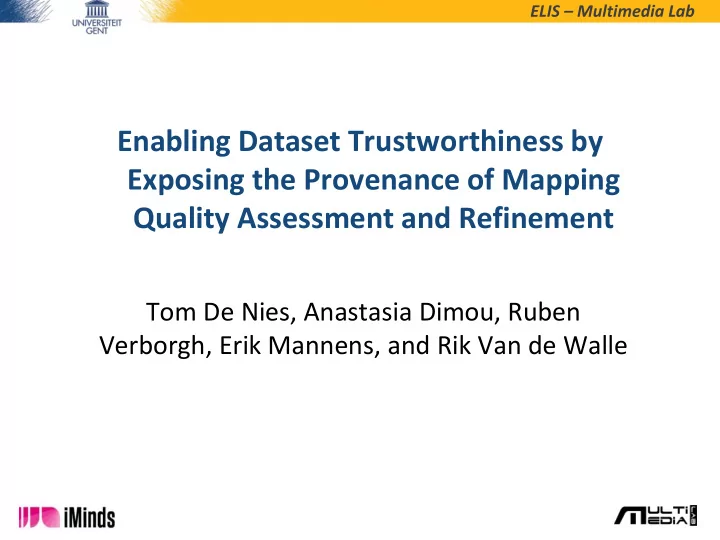

ELIS – Multimedia Lab Enabling Dataset Trustworthiness by Exposing the Provenance of Mapping Quality Assessment and Refinement Tom De Nies, Anastasia Dimou, Ruben Verborgh, Erik Mannens, and Rik Van de Walle
ELIS – Multimedia Lab Contents Context: assessing trust of RDF datasets Mapping semi-structured data to RDF Mapping quality assessment and refinement workflow Capturing provenance of the workflow Deriving Trust
ELIS – Multimedia Lab Context How do we decide to trust an RDF dataset or not? One important aspect is: where did it come from? In a lot of cases, the RDF data was mapped from semi- structured data using a mapping language. In our lab, we developed such a language: The RDF Mapping Language http://rml.io
ELIS – Multimedia Lab Mapping semi-structured data to RDF W3C R2RML exists to map databases to RDF To map all other data formats, there’s RML The cool thing: RML definitions are RDF themselves → they can be queried using SPARQL The problem: not all mappings are perfect right away
ELIS – Multimedia Lab Mapping quality assessment and refinement workflow Evaluate data quality during the mapping stage Based on RDFUnit tests for mapping documents instead of data Turns out to be much more efficient for mapping documents than for data (seconds vs. hours) Generates violations (warnings and errors), based on which the mapping definitions are refined
ELIS – Multimedia Lab Capturing provenance of the workflow Goal: evaluate the difference (delta) in trust between the new and old dataset refinement oldRML newRML generates generates oldRDF newRDF Diff in trust?
ELIS – Multimedia Lab Deriving Trust Query the provenance for violations and see: - How many there are - How bad they are (e.g., errors can be worse than warnings) The cool thing: it’s all RDF , so it can be done with standard reasoning tools (N3, SPARQL, …)
Recommend
More recommend